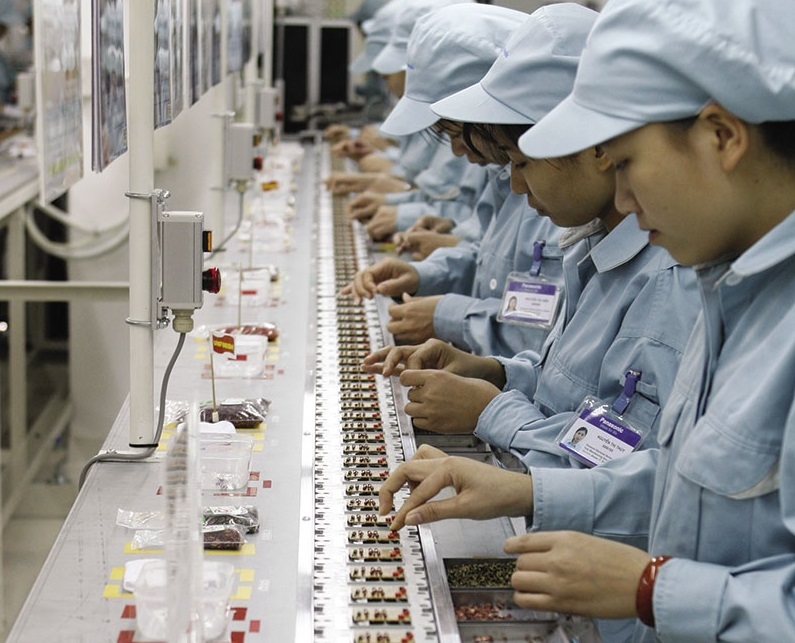Growth forecasts upbeat due to FDI
 |
| The foreign direct investment prospects in Vietnam remain quite bright, Photo:Duc Thanh |
The International Monetary Fund (IMF) has concluded its annual consultation with Vietnam, releasing a fresh economic growth rate forecast for the country of 6.6 per cent this year, lower than the 6.7-per-cent rate targeted by the government.
One of the key drivers for growth pinpointed by the IMF is an inflow of disbursed foreign direct investment (FDI), which hit $17.5 billion last year, up 10.8 per cent against 2016, and up 40 per cent compared to 2014. In the first half of this year, the figure reached $8.37 billion, up 8.4 per cent on-year.
“Vietnam’s dynamic, highly open economy continues to perform well. The solid performance is aided by macro-economic and financial stability, stepped up economic reforms, and inflows of FDI which are enabling structural transformation and are raising the growth potential,” said the IMF consultation report on Vietnam’s economic performance. “The strong economic momentum is expected to continue.”
Last week, Standard Chartered Bank also released its forecast for Vietnam’s economic outlook, expecting the economy to grow by 7 per cent this year, higher than its previous forecast of 6.8 per cent.
“We are positive on Vietnam’s medium-term growth based on strong manufacturing activity as FDI inflows to manufacturing remain strong. We believe Vietnam will remain one of the fastest-growing economies in Asia in 2018,” said the bank’s economist for Asia Chidu Narayanan.
According to the bank, Vietnam’s FDI inflows are set to remain high in 2018, led by the manufacturing sector, which rakes in close to 50 per cent of inflows.
Meanwhile, the IMF said Vietnam has been witnessing a long track record of strong, inclusive growth. The economy is “one of the most dynamic in East Asia, with growth averaging 6.5 per cent a year during the 2000–2016 period.”
The foreign-invested manufacturing sector generates a large trade surplus equalling 15.5 per cent of GDP. It is dominated by electronics multinationals and apparel producers, like Intel, Samsung, LG, Sumitomo, Pouchen, and Texhong, integrated into broader Asian supply chains and engaged in final assembly and processing, and higher value-added activities are also increasingly located in Vietnam.
David John Whitehead, chairman of Australian-Vietnamese joint venture Mavin Group, told VIR that along with manufacturing and textiles, agriculture is becoming a new target for foreign firms in Vietnam.
“I am seeing more and more Australian firms coming to Vietnam to enter many sectors,” Whitehead said.
A few weeks ago, Mavin inaugurated its fifth feed mill in Vietnam, worth $30 million, in the southern province of Dong Thap. This is also the biggest feed mill in the Mekong Delta region, annually producing 400,000 tonnes of livestock feed and aquafeed. The mill is equipped with modern technology from Germany’s Bühler Group, including robotics and state-of-the-art equipment.
Mavin will continue to invest in other projects in Dong Thap, with the total investment capital in the province expected to be over $70.5 million.
Slightly over a week ago, the European Chamber of Commerce in Vietnam (EuroCham) released the results of its Business Climate Index for 2018’s first quarter. Vietnam’s index score was 78, one point up from the previous quarterly survey. Almost 90 per cent of respondents said they are either maintaining or increasing their investment in the country. 45 per cent of EuroCham members intend to maintain their level of investment in Vietnam, up 9 percentage points from last year’s fourth quarter.
“EuroCham hopes that this interest inspires the Vietnamese government to improve the business environment further, particularly regarding the changes to the legal framework that will enable Vietnam to fulfil its commitments under the EU-Vietnam Free Trade Agreement (EVFTA), expected to be ratified later this year,” said EuroCham’s co-chairman Nicolas Audier.
Recently, the World Bank also issued its new forecast for Vietnam’s economic growth, which it expects to reach 6.8 per cent this year -up from 6.5 per cent in the bank’s previous projection, largely thanks to a recovery in FDI and the performance of domestic private firms, in addition to a cyclical increase in the global demand.
Sebastian Eckardt, lead economist for the World Bank in Vietnam, told VIR that the FDI prospects in Vietnam remain quite bright.
According to the Ministry of Planning and Investment’s Foreign Investment Agency, the registered FDI sum by June 20 hit $20.3 billion, an increase of 5.7 per cent over the same period last year.
“The economy’s health is good, and it is likely that Vietnam will continue attracting big foreign-invested projects from now until the end of the year,” Eckardt said.
The National Assembly has set a target of reaching total registered FDI of $27.5-28.5 billion for the whole of 2018, of which the disbursed figure is targeted to be $21 billion, far higher than the $17.5 billion last year.
What the stars mean:
★ Poor ★ ★ Promising ★★★ Good ★★★★ Very good ★★★★★ Exceptional
Related Contents
Latest News
More News
- Kolon signs $48 million airbag supply deal with Autoliv (December 15, 2025 | 18:14)
- National Assembly approves Vinh–Thanh Thuy expressway project (December 15, 2025 | 18:02)
- Quang Tri green-lights $1.59 billion LNG-fired power project (December 15, 2025 | 17:59)
- Stress laid on high-quality FDI inflows (December 15, 2025 | 11:00)
- Can Tho utilises its growth advantages (December 15, 2025 | 09:09)
- Ca Mau unlocking potential to shape a more sustainable future (December 15, 2025 | 09:02)
- Major projects to be inaugurated nationwide (December 15, 2025 | 08:00)
- MoF workshop highlights mounting concerns over ODA on-lending costs (December 12, 2025 | 16:05)
- National Assembly approves pilot mechanisms to accelerate major projects in Hanoi (December 12, 2025 | 11:29)
- Legislation gives government flexibility for loan guarantees (December 11, 2025 | 18:04)

 Tag:
Tag:






















 Mobile Version
Mobile Version